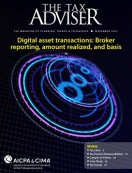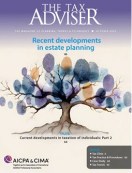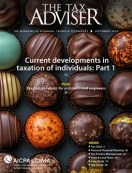- newsletter
- TAX INSIDER

Estate planning for blended families
Please note: This item is from our archives and was published in 2017. It is provided for historical reference. The content may be out of date and links may no longer function.
Related
Valuation of family-owned entities for estate and gift tax purposes under Sec. 2704
Sale of a residence in a QPRT
Recent Developments in Estate Planning: Part 2
The chance that a marriage entered in the United States this year will end in divorce is about 50%. In 2013, 40% of marriages included at least one spouse who had been previously married. As a result, a tremendous number of blended families exist in the United States today (a blended family is defined as a family that includes children from a previous marriage of one spouse or both). Estate planning for these individuals is much more complicated than it is for any other group.
One of the biggest challenges is that most people who remarry already have kids. Frequently, both spouses in a second marriage want some or all of the assets they bring into the marriage to go to their biological children rather than their stepchildren upon their death. However, they also frequently wish the surviving spouse to have use of the assets or to receive the income from the assets until the surviving spouse dies. The easiest and fairest way to achieve this is with either an AB trust or an ABC trust.
Here is how these trusts work. Suppose Spouse X divorces from his first wife and marries Spouse Z. Spouse X later dies, survived by Spouse Z. One of the concerns of leaving assets directly to a surviving second spouse (Spouse Z) is that upon Spouse Z‘s death, the assets will pass to Spouse Z‘s family and not Spouse X‘s family. For example, assume Spouse X‘s estate is worth $3 million and Spouse X leaves half to Spouse Z. Spouse Z inherits $1.5 million, and Spouse X‘s children inherit $1.5 million. However, if Spouse Z dies right after Spouse X, the $1.5 million received by her would pass under Spouse Z‘s will to her children or other family members.
AB trusts
Rather than leaving the money directly to the second spouse, Spouse X can leave his or her share in a trust. The trust pays income and principal for certain expenses to Spouse Z for life. Upon Spouse Z‘s death, the remainder of the trust is distributed to Spouse X‘s children. Thus, Spouse Z would have the use of the $1.5 million in the trust during her lifetime, but at her death, the principal would pass to Spouse X‘s children, not Spouse Z‘s children.
So, for example, $1.5 million would be allocated to the A trust with income for life to Spouse Z with the remainder going to Spouse X‘s children. The B trust is allocated for the benefit of Spouse X‘s children. Spouse X’s children will receive the corpus of the first trust, and the $1.5 million in their trust.
ABC trusts
An ABC trust is a version of the AB trust concept except that various assets are allocated to each trust and each trust has a different set of rules. Here is an example of how this works.
A trust: The house and 25% of the money to be distributed outright to Spouse Z.
B trust: 50% of the money held in trust with income for life to Spouse Z, but on the death of that spouse, the remainder back to Spouse X‘s children.
C trust: 25% of the money and the life insurance to be distributed to Spouse X‘s children. Under this plan, Spouse X‘s children receive 25% of the money and the life insurance at Spouse X‘s death, and another 50% upon the death of Spouse Z from the B trust. The spouse receives the A trust free of any restrictions. The terms of the B trust are irrevocable so if the Spouse Z gets remarried, gets sued, goes to a nursing home, or dies, the B trust is totally protected for Spouse X‘s children.
The primary reason taxpayers used to create AB trusts and ABC trusts was to avoid the estate tax. With the estate tax exemption at $5.49 million for 2017 and adjusted for inflation each year, and the ability to elect portability between spouses bringing the total exemption up to almost $11 million, the estate tax affects few people. Now these types of trusts are commonly used for blended families. (Of course, some states have a much lower exemption from their estate or inheritance taxes than the federal estate tax does.)
As for how these trusts are taxed, typically the A trust is a grantor trust, meaning the tax falls on the grantor, who is responsible for reporting the income on his or her Form 1040, U.S. Individual Income Tax Return. The B trust is irrevocable and needs to file a Form 1041, U.S. Income Tax Return for Estates or Trusts, and issue Schedule K-1 forms to the beneficiaries, where they pay tax on anything that the trust corpus has made (the distributable net income) The C trust is treated the exact same way as the B trust for tax purposes.
In summary, AB trusts and ABC trusts used to be a method to shelter assets from the estate tax. Today practitioners are using them more and more for blended families.
Craig W. Smalley, MST, is an enrolled agent and the founder and CEO of CWSEAPA PLLC, which provides accounting and financial services.














